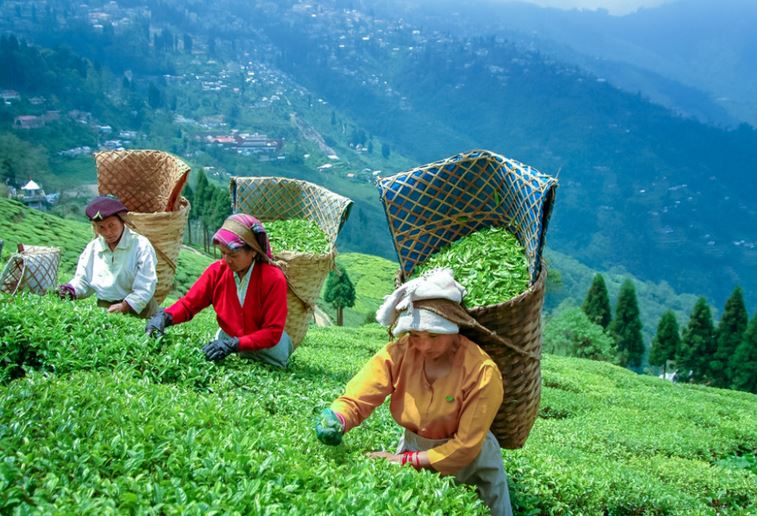Challenges Facing Darjeeling Tea Production

Table of Contents
Climate Change and Environmental Concerns
The delicate ecosystem of Darjeeling, nestled high in the Himalayas, is highly susceptible to the effects of climate change. Unpredictable weather patterns and environmental degradation pose significant threats to Darjeeling tea production.
Impact of Unpredictable Weather Patterns
Unpredictable rainfall, extreme temperatures, and frost significantly affect tea yield and quality. The region's unique microclimate, crucial for the development of the distinctive muscatel flavor, is increasingly unstable.
- Reduced leaf production: Erratic rainfall leads to inconsistent growth, resulting in lower yields.
- Damage to tea bushes: Frost and extreme temperatures can severely damage or even kill tea bushes, impacting future harvests.
- Impact on the delicate muscatel flavor profile: Changes in temperature and humidity can alter the chemical composition of the tea leaves, affecting the prized muscatel flavor.
The unpredictable nature of monsoon seasons in recent years, coupled with increasing instances of hailstorms and frost, has resulted in significant losses for Darjeeling tea farmers. Landslides, exacerbated by deforestation and erratic rainfall, further threaten the stability of tea gardens and access to plantations.
Pest and Disease Outbreaks
Changing climatic conditions create ideal breeding grounds for pests and diseases, increasing their incidence and severity. This necessitates more intensive and costly pest management strategies, often with negative environmental consequences.
- Increased incidence of blights and other fungal infections: Warmer temperatures and increased humidity promote the growth of various blights and fungal infections, impacting leaf quality and yield.
- Higher pesticide usage: The need to control pests and diseases often leads to increased pesticide use, raising concerns about the environmental impact and potential health risks.
- Potential impact on tea quality and sustainability: Excessive pesticide use can negatively affect the tea's flavor and aroma, and compromise the sustainability of Darjeeling tea production.
Common pests affecting Darjeeling tea include various types of aphids and mites, while fungal diseases like blister blight pose a significant threat. Finding a balance between effective pest control and environmentally friendly practices is a major challenge for Darjeeling tea farmers.
Labor Shortages and Wage Issues
The Darjeeling tea industry faces a critical labor shortage, primarily due to the migration of younger generations to urban areas seeking better opportunities.
Young People Migrating to Urban Areas
Low wages, difficult working conditions, and a lack of social amenities in tea garden communities are driving young people to seek employment in urban centers.
- Shortage of skilled labor: The exodus of younger workers leads to a shortage of skilled tea pluckers and other essential personnel.
- Reduced productivity: A smaller and less experienced workforce directly impacts the overall productivity of tea gardens.
- Difficulties in maintaining tea quality standards: The lack of skilled labor can affect the quality of plucking and processing, impacting the final product.
This rural-urban migration is a complex socio-economic issue, influenced by factors such as limited educational opportunities, lack of access to healthcare, and a perception of better prospects in urban areas.
Fair Wages and Worker Welfare
Ensuring fair wages and improving the working conditions of tea pluckers is paramount to the sustainability of Darjeeling tea production. Addressing worker welfare concerns is crucial for attracting and retaining a skilled workforce.
- Improving living standards: Providing access to decent housing, healthcare, and education is essential for improving the lives of tea garden workers.
- Addressing health and safety concerns: Implementing safety measures and providing access to healthcare services are crucial for protecting the well-being of workers.
- Promoting worker rights: Ensuring fair wages, reasonable working hours, and the right to organize are vital for fostering a just and equitable working environment.
Various initiatives, including government regulations and NGO interventions, are underway to improve the lives of tea garden workers, but substantial progress is still needed.
Market Competition and Economic Factors
Darjeeling tea faces intense competition in the global tea market, impacting its profitability and long-term sustainability.
Competition from Other Tea-Producing Regions
Darjeeling tea competes with other tea-producing regions, many of which offer lower-priced alternatives. This price pressure necessitates strategic adaptation and differentiation.
- Price pressure on Darjeeling tea: The availability of cheaper teas from other regions puts downward pressure on Darjeeling tea prices.
- Challenges in maintaining market share: Darjeeling tea producers face the challenge of maintaining their market share amidst intense competition.
- Need for product differentiation: Highlighting the unique qualities and superior taste of Darjeeling tea is crucial for maintaining its competitive edge.
Strategies such as emphasizing the unique terroir, promoting the Darjeeling brand's heritage, and focusing on niche markets are crucial for maintaining competitiveness.
Fluctuating Global Tea Prices
Global tea prices are volatile, subject to factors such as weather patterns, production levels, and international demand. This volatility significantly impacts the profitability of Darjeeling tea production.
- Financial instability for farmers: Fluctuating prices create financial uncertainty for Darjeeling tea farmers, impacting their livelihoods and investment in their farms.
- Increased risk of abandoning tea cultivation: Low and unstable prices can lead farmers to switch to other crops, jeopardizing the future of Darjeeling tea.
- Potential decline in quality: Financial constraints can lead to compromises in quality control and sustainable farming practices.
Establishing price support mechanisms and exploring alternative income generation strategies for tea farmers are essential for mitigating the risks associated with price volatility.
Authenticity and Counterfeit Products
The prestige of Darjeeling tea makes it a target for counterfeiters, posing a threat to its reputation and market value.
Protecting the Darjeeling Brand
Counterfeit Darjeeling tea, often blended with inferior teas and falsely labeled, undermines the reputation and market value of authentic Darjeeling tea. Protecting the Darjeeling brand requires proactive measures.
- Protecting geographical indicators (GI): Strengthening the legal protection of the Darjeeling GI is crucial to prevent the use of the name on counterfeit products.
- Tackling illegal blending and labeling practices: Enhancing enforcement mechanisms to prevent fraudulent blending and mislabeling is necessary.
- Educating consumers: Raising consumer awareness about the characteristics of authentic Darjeeling tea and how to identify counterfeit products is essential.
The Darjeeling Tea Association plays a vital role in protecting the GI and combating counterfeiting through various initiatives.
Maintaining Quality and Standards
Maintaining the consistent quality and unique characteristics of Darjeeling tea is vital for its brand reputation and continued success.
- Stringent quality control measures: Implementing rigorous quality control measures throughout the production process is crucial for ensuring consistent quality.
- Traceability systems: Implementing traceability systems ensures that the origin and quality of the tea can be verified.
- Educating farmers on sustainable practices: Training farmers on sustainable agricultural practices helps to maintain the quality of the tea leaves while protecting the environment.
Strict adherence to quality standards, from plucking to processing and packaging, is crucial to preserve the reputation of Darjeeling tea.
Conclusion
The future of Darjeeling tea production faces significant challenges, requiring proactive and collaborative efforts from producers, policymakers, and consumers. Addressing climate change impacts, ensuring fair labor practices, navigating market competition, and protecting the Darjeeling brand are crucial steps in preserving this iconic tea. By understanding and tackling these challenges, we can ensure the continued production of high-quality Darjeeling tea for generations to come. Support sustainable Darjeeling tea production by choosing authentic, ethically sourced products. Let's work together to safeguard the future of Darjeeling tea production.

Featured Posts
-
 West Bengal Weather Forecast High Tide And Temperature Expected During Holi
May 04, 2025
West Bengal Weather Forecast High Tide And Temperature Expected During Holi
May 04, 2025 -
 Britains Got Talent Analyzing Teddy Magics On Air Incident
May 04, 2025
Britains Got Talent Analyzing Teddy Magics On Air Incident
May 04, 2025 -
 Trainer Defends Lizzos Approach To Fitness
May 04, 2025
Trainer Defends Lizzos Approach To Fitness
May 04, 2025 -
 Foxs New Streaming Strategy Peter Distad Takes The Helm
May 04, 2025
Foxs New Streaming Strategy Peter Distad Takes The Helm
May 04, 2025 -
 Fleetwood Macs Chart Run Continues A Deep Dive Into Their Latest Release
May 04, 2025
Fleetwood Macs Chart Run Continues A Deep Dive Into Their Latest Release
May 04, 2025
